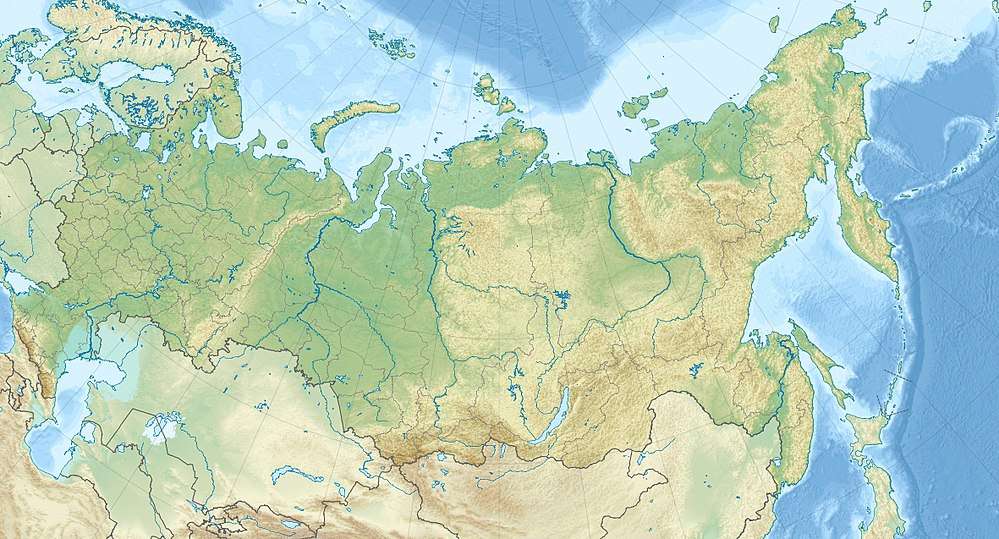Udurchukan Formation
The Udurchukan Formation is a geological formation located in Amur Region, Far East Russia. Based on palynomorphs such as Wodehouseia spinata the Udurchukan is considered of Maastrichtian age of the Late Cretaceous, during the Cretaceous Period.
| Udurchukan Formation Stratigraphic range: Maastrichtian ~70–66 Ma | |
|---|---|
| Type | Geological formation |
| Unit of | Tsagayan Group |
| Underlies | Bureya Formation |
| Overlies | Kundur Formation |
| Thickness | 11 metres (40 ft) exposed at Kundur locality |
| Lithology | |
| Primary | Conglomerate, mudstone, diamictite |
| Other | Sandstone |
| Location | |
| Coordinates | 49.5°N 129.5°E |
| Approximate paleocoordinates | 51.4°N 115.8°E |
| Region | |
| Country | |
| Extent | Zeya-Bureya Basin |
 Udurchukan Formation (Russia) | |
Fossil record
Inasmuch as Wodehouseia spinata and Aquillapollenites subtilis are known in the Americas only from the Late Maastrichtian, the presence of these palynomorphs in the Udurchukan caused Godefroit to consider the unit and its lambeosaur dominated fauna to be coeval with the Lance Formation and Hell Creek Formation. However, research in the Songliao Basin indicates Wodehouseia spinata is also known from the early (albeit not basal) and middle Maastrichtian of Asia.
The latest view, appearing in the paper on comparative osteology of Edmontosaurus and Shantungosaurus, is that one Udurchukan Formation locality, Kundur, is late−early Maastrichtian; and the other, Blagoveschensk, is early−late Maastrichtian. The Udurchukan Formation now appears somewhat older than the Lance and Hell Creek, albeit not by much.
Dinosaurs
| Dinosaurs reported from the Udurchukan Formation | ||||||
|---|---|---|---|---|---|---|
| Genus | Species | Location | Stratigraphic position | Material | Notes | Images |
| Amurosaurus | A. riabinini | Blagoveschensk | A lambeosaurine hadrosaur | |||
| Arkharavia | A. heterocoelica | A single tooth, proximal tail vertebrae | The holotype belongs to a sauropod, but the other remains probably belong to an indeterminate hadrosaur.[1] | |||
| Kerberosaurus | K. manakini | Blagoveschensk | A saurolophine hadrosaur | |||
| Kundurosaurus | K. nagornyi | Kundur | A saurolophine hadrosaur; possible synonymous with Kerberosaurus |  | ||
| Olorotitan | O. arharensis | Kundur | A hadrosaur |  | ||
Other fossils
- Vertebrates
- Amuremys planicostata
- Tarbosaurus bataar
- Aublysodon sp.
- Richardoestesia sp.
- Shamosuchus sp.
- Troodon sp.
- cf. Dromaeosaurus sp.
- cf. Saurornitholestes sp.
- Cimolodonta indet.
- Crocodylia indet.
- Hadrosaurinae indet.
- Lindholmemydidae indet.
- Nodosauridae indet.
- Testudines indet.
- Titanosauria indet.
- Theropoda indet.
- Trionychidae indet.
- Insects
- Mesosigara kryshtofovichi
- Flora
- Cupressinoxylon sp.
See also
- Geology of Russia
- Fossils of Russia
References
- Mannion, Philip D.; Upchurch, Paul; Barnes, Rosie N.; Mateus, Octávio (2013). "Osteology of the Late Jurassic Portuguese sauropod dinosaur Lusotitan atalaiensis (Macronaria) and the evolutionary history of basal titanosauriforms". Zoological Journal of the Linnean Society. 168: 98. doi:10.1111/zoj.12029.
Bibliography
- Y. A. Popov. 1971. Historical development of the infraorder Nepomorpha (Heteroptera). Akademiya Nauk SSSR, Trudy Paleontologicheskogo Instituta 129:1-228